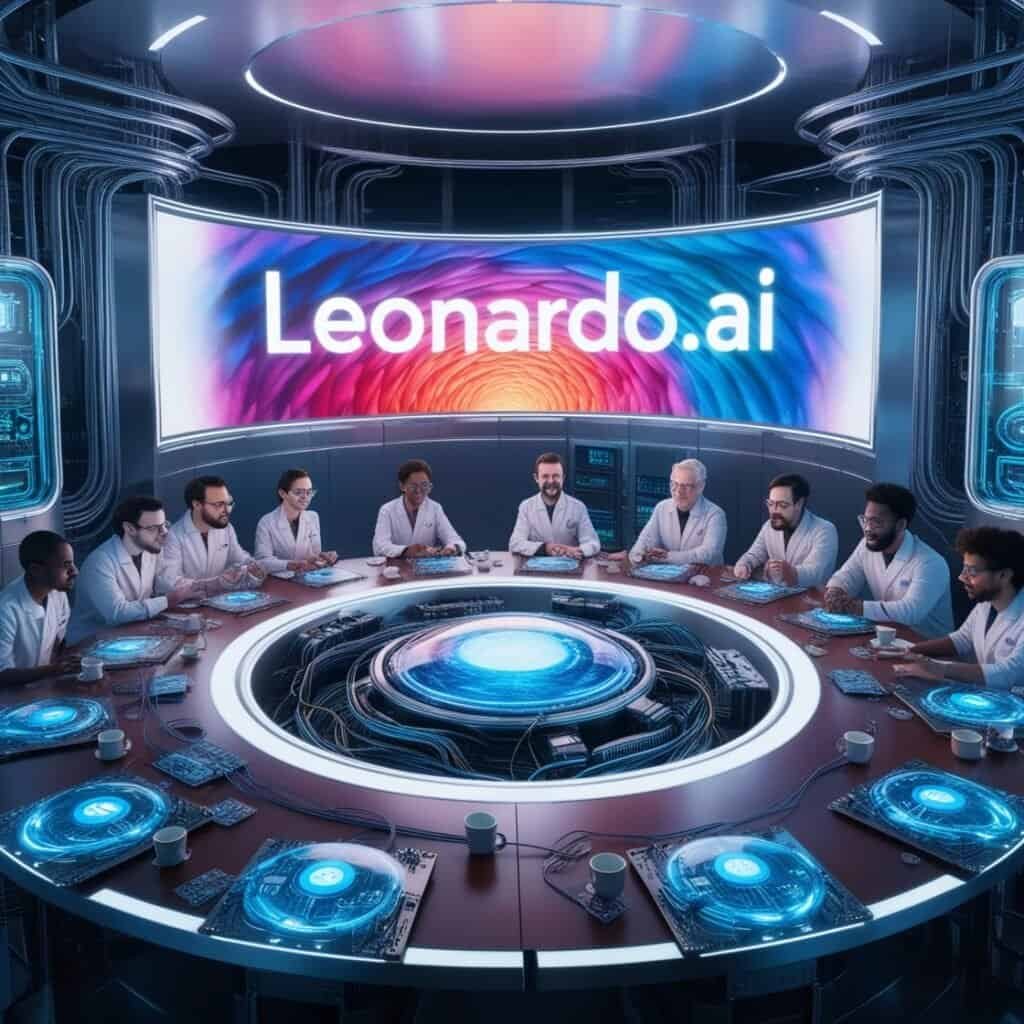Introduction to Leonardo.ai
Leonardo.ai is perfect for artists, designers and hobbyists to create pictures at the push of a button. Skeptics can look to Leonardo.ai, a digital tool that empowers artists, designers and hobbyists to create pictures at the push of a button. Largely using artificial intelligence, Leonardo.ai simplifies the traditional image-creation process in ways that make it easier and more accessible than ever before. Born out of the convergence of neuroscience, software and art, Leonardo.ai has the power to shake up our preconceived notions of what it means to be creative – and unleash the power of your own innate imaginations.
Today we look at: What can Leonardo.ai do? What makes Leonardo.ai stand out? How can I use Leonardo.ai? Tips for using Leonardo.ai. I hope you enjoy it.
What is Leonardo.ai?
Artwork created by Leonardo.ai is an artificial intelligence system that creates art from inputs. The tool can quickly generate images from words and phrases. It does this by applying algorithms to user inputs, delivering an outcome that is inspired by the input. Leonardo.ai is unique in that it uses artificial intelligence to – to some extent – understand nuances in what users produce. This creates images that appear to be uniquely artistically crafted.
Further, that it doesn’t restrict exploration to one style or genre is important: users can wander the gamut from digital paint to concept art to photoreal imagery, with Leonardo.ai being a go-to standby in the creative toolbox.
Brief History and Development
The genesis of Leonardo.ai comes from two roots. The first revolves around the increasingly powerful symbiosis of art and technology, with a growing demand for new and special tools to explore new creative domains. The second is what was considered ‘AI art’ 10 years ago: tools that can produce simple image-generation by specific and elementary rules, and – thanks to progresses in machine learning and neural networks – what platforms like Leonardo.ai can produce now: extremely complex, much more beautiful outputs.
Since then, Leonardo.ai has been updated and improved many times, as its development team responds to user feedback and advancing technology and makes the system fit for continuing service as AI imagery development.

The Power of AI in Image Creation
Understanding AI Art Generation
In some versions, it uses training datasets of millions of images created by humans to recognise patterns, colours and styles; it can then generate new art, informed by many different styles, periods/movements or even sticking to particular themes. Much of this allows for astonishing levels of creativity, something that many of us would not have imagined was possible to achieve by machines when it comes to art.
Ultimately, AI works alongside human creativity, not supplanting it. Artists can give prompts, indicate themes, or provide part of an image, and the AI produces on the basis of those inputs, often resulting in something that merits further artist exploration. The symbiosis of the human and the machine is a hallmark of the emergence of the AI in art.
Benefits of Using AI for Creative Projects
The major selling point here is efficiency – Leonardo.ai will produce rendering-quality images in much, much less time than it would take an artist to produce them without help. Since so many creative projects involve a lot of time-consuming groundwork, this might be a very welcome relief. Instead of spending months creating one image, artists might be able to focus on other stages of their projects – such as conceptual development or promotion.
Further, AI can break creative blocks. Take an artist who’s struggling to proceed with an idea and is in need of a fresh perspective; she can use it to rapidly generate numerous variations of the idea she’s working on, until she arrives at something new and perhaps even useful. Quick and easy experimental stylistic or conceptual deviations from an original idea encourage exploration.
Features That Set Leonardo.ai Apart
User-Friendly Interface
Leonardo.ai features a modern, intuitive interface that both new users and old hands can use with ease. The structure ensures everything is within reach and, thanks to tutorials and tooltips, newcomers don’t feel lost or intimidated.
This user-centric design philosophy renders the software accessible and usable by anyone, even if they are what is called a ‘technical virgin’ in the developer jargon – neither capable nor concerned with implementing codes. The ease of use is further supported by a sturdy support system that can not only help users troubleshoot the system but can also assist them in optimising their experience with it.
Advanced Algorithms and Techniques
At the heart of the computer’s power is its proprietary algorithm, which employs deep learning to fully comprehend the artist’s style – enabling the software to emulate that style with exceptional fidelity. The resulting images will be of high quality, with exquisite detail and rich textures.
Furthermore, the system learns continually from interactions with users, thus improving its capacity to generate bespoke outputs. Adaptive learning means that the AI remains sensitive and able to produce work that is relevant to current and changing fashions and personal tastes.
Customization and Flexibility
Leonardo.ai gives users the capacity to make those creative works their own, for example allowing its algorithm-generated works to be recoloured or to override entire brush styles. Art can be tailored and simplified, but even more power rests with the consumer than the creator. The means of production might be out of the artist’s hands, but post-creative output, the rest is up to us. The ultimate motto is: it’s about time.
And then save everything – which settings you preferred and which presets worked best – so artists can remain consistent across multiple projects or jump back in without having to start at square one every time.
How to Get Started with Leonardo.ai
Creating Your Account
Creating an account to get started with Leonardo.ai is pretty easy. To begin, a user has to register on the Leonardo.ai website and provide name, email and password. A confirmation email follows to verify the account.
Once the account is verified, the user can log in, explore, and then, whether with a free trial or a subscription, tailor the service according to his or her needs.
Exploring the Dashboard
Once you have logged on, you will see your dashboard. It has a well-organised interface, with lots of tools and features. The more familiar you are with the layout, the more you will use. There are sections for creating new projects, for viewing tutorials, and for viewing saved works.
Furthermore, sites offer forums and resources with tips and inspirations. Of this sense of community, online forums have the most impact: looking up model cars on the internet is one thing, but discovering a community of aficionados who can offer advice, encouragement and techniques is another.
First Steps in Image Creation
After selecting a project type (Still, Remix, Video, Nightscape), users can select from a variety of templates (these give the system an idea of the type of image to produce). Once a prompt (under ‘what’) or concept (under ‘what if’) is typed in, the AI will create an initial set of images relevant to the user’s requests.
When the AI has produced these, users can further refine their own list of potential outputs by narrowing down the range of acceptable styles and colours (and other parameters) each time. In this way creative and experimental filtering allows owers to hone in on the output that ultimately works for them.

Tips for Maximizing Your Creative Output
Utilizing Available Tools and Features
There are many different tools available in Leonardo.ai that might lend themselves to different approaches and processes – getting comfortable with all of them might lead you to generate more creative outputs. Play with all of the brushes and textures when drawing a picture, for instance.
In addition, learning how to overlay elements and apply filters can transform a simple image into a complex work of art. Spend some time trying out each feature to find the kinds of combinations that will work with your own personal aesthetic.
Collaborating with Other Creators
Mutual interaction with other users of Leonardo.ai can add dynamism to creativity. Take part in community projects or challenges that involve working together with artists from around the world and exchanging ideas.
It also helps to spawn fresh ideas that might not emerge working on your own, and it can lead to work that displays this blend of styles and influences, creating something new and compelling as a consequence.
Real-World Applications of Leonardo.ai
Art and Design Industries
The image-generation tool Leonardo.ai can be used in similar applications in the creative field of art and design. Agencies and freelance designers alike rely on such systems to generate mock-ups for branding, marketing campaigns and product designs, often requiring a large number of variants to be generated quickly in order to present many different options to their clients.
Furthermore, visual artists can use AI-generated images as a basis for new works, adding their own marks and transformations, so what we end up with is an interplay of technology and practice, or high-tech and low-tech that marries technical research with artistic themes and commentaries. The outcome of this new creative paradigm is yet another kinetic work in progress.
Marketing and Branding
The work of whipping up high-quality visuals is an essential part of marketing. Leonardo.ai aims to help marketing teams create tailored promotional images that will connect with specific groups. The company, which successfully raised $2 million by the end of its crowdfunding stage this month, wants to bring personalisation to marketing, similar to how Airbnb personalises its offerings. Currently, many companies are using AI-generated artwork that can look indiscernible from the work of humans. This approach saves companies projects while improving the quality of the images promoted to audiences.
Furthermore, brands can dabble with complementary visual narratives in line with their communications, establishing holistic and remarkable brand identity regardless of the marketing platform. Leonardo.ai’s versatility itself makes it a valuable tool in developing innovative marketing approaches.
Personal Projects and Hobbies
However, the site could have applications beyond the professional realm as well. It could be a valuable source of inspiration for personal projects and hobbies, such as creating fan art, designs or simply playing around with an art- styled twist on the usual selfies. It’s is a wonderfully accessible way to explore ideas, even if you simply need to look outside your own realm of interests.
The most important aspect for any hobbyist (artist or not) is the creation process itself, with AI aiding facilitating the production and allowing the user to focus more on the process of creation rather than the technical aspects involved in image generation, which can often in itself be extremely frustrating. The user’s experience of fun and enjoyment is enhanced through AI.
Conclusion
Recap of Leonardo.ai’s Advantages
Leonardo.ai represents the future of images because, beneath the aesthetic makeup, it is a new technological, creative and collaborative tool. It support artists and creators to experience their ideas in a user-friendly designed environment, equiped with powerful advance algorithms, back-end systems and functions. Instead of thinking of Leonardo.ai just as yet another photo editing tool, it’s better to understand it as the precursor of a new era for image making. Thanks to its efficiency, customisability and social elements, Leonardo.ai could inspire creativity on a scale never seen before.
Encouragement to Dive into AI Image Creation
With AI becoming increasingly more valuable as we adapt to it, platforms such as Leonardo.ai will prove to be game-changers in how art and design will be handled in the future; we encourage you to test it out, let the artwork flow out of you, and see first-hand how AI can complement your art.

